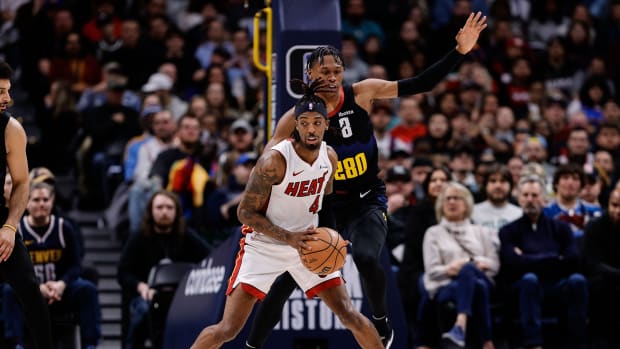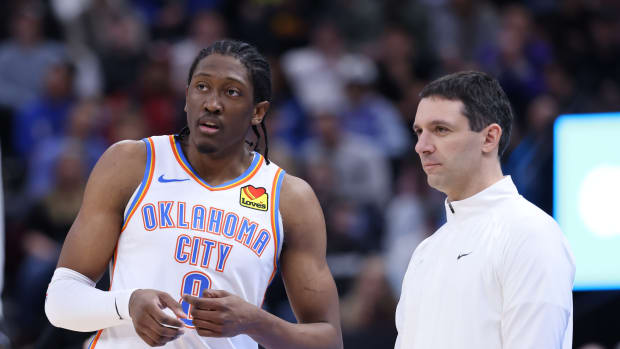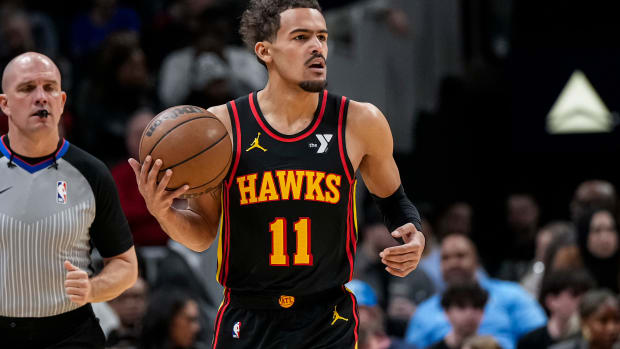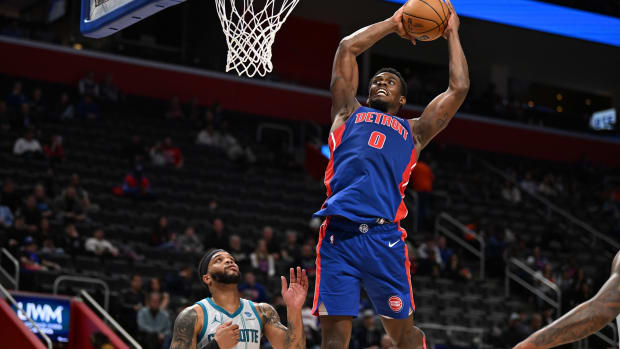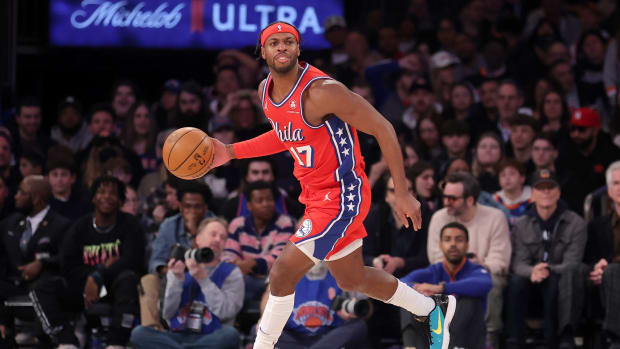Jamal Crawford: Last of the Ballers
“Shut me down? Shut me down!?!”
Jamal Crawford stares at the sideline, incredulous. It is August on the outskirts of Seattle. In a few months Crawford will debut for the Timberwolves, his seventh team in 18 NBA seasons, expected to do what he’s always done—get irrationally hot irrationally fast. But for now, on a summer Sunday night, in a half-empty college gym that smells of hot dogs and sweat, he is playing for pride. Still, this is his turf—his pro-am, in fact, the appropriately named Crawsover. And some guy on the opposing bench has the temerity to suggest that Crawford can be locked up because, why? He’s too old? Washed up?
If this were 20 years ago, it would be on. Back then Crawford lived to embarrass defenders. Didn’t matter who, where or when. Blow past you, and Crawford might instead pull it back out so he could cross you over a second time. No one was off limits. When he was a 16-year-old at Rainier Beach High, the SuperSonics invited him to an open run, even though he looked 13 and weighed a buck-forty. Jamal? He dribbled down in transition, saw Detlef Schrempf—three-time NBA All-Star Detlef Schrempf, pride of Seattle Detlef Schrempf—and, well, “I can’t even articulate what he did,” Sonics assistant Steve Gordon later told the San Jose Mercury News. “He basically broke Detlef’s feet at half court. We thought Detlef was hurt.”
That’s how Jamal rolled. “You don’t have enough money to play me one-on-one,” he’d tell dudes, but then of course he’d play them anyway. But times have changed. Crawford is 37 now. He’s made more than $100 million. He doesn’t have to prove anything to anybody, especially some junior college nobody, here in a gym full of old men with loud opinions. Besides, when you get to Crawford’s age, you have to pace yourself. Adapt. Play the long game.
Or at least that’s what everyone tells him.
Growing up, Crawford used to ask friends whose game his most resembled. They’d size him up—too tall and shot-happy to be a point guard, too skinny and herky-jerky to be a shooting guard—and say, “Nobody.” And this broke his heart, because all he wanted was to hear Penny Hardaway, or maybe Isiah Thomas or Allen Iverson.
Two decades later the 6'5" Crawford still doesn’t play like anybody else, nor does anyone really play like him. He skips as much as runs, his dribble nearing chest height, where coaches teach you not to keep it. When he crosses over, he does so precipitously and with devastating speed. From afar he appears to be all limbs upon which a giant round head bobs, as if the character from those life is good T-shirts came to life. “Damn, you got a lot of juice left in those legs!” Dirk Nowitzki told him last season, and it’s true.
He remains in demand. When Crawford became a free agent last summer, the Warriors recruited him. LeBron called: Come to Cleveland. Instead Crawford signed for two years and $8.9 million with Minnesota, a promising team that nonetheless hasn’t made the playoffs since 2004 and whose coach, Tom Thibodeau, is known to be something of a stickler for defense (something that Crawford, it’s fair to say, is not). The match didn’t seem to make a lot of sense.
Then again, Crawford has spent his life confounding expectations. After all, who would have thought that of all the players in the 2000 draft class, Crawford would be the last man standing? He has never been an All-Star, never played in the Finals and has started barely a third of his games. He’s about to play for his 18th coach in 18 seasons, which, as he points out, “literally might be a record.” And yet he’s scored more points than Magic Johnson or Chris Mullin and sunk more threes than Iverson and Mark Price combined. This season, barring injury, he’ll pass Ewing, Olajuwon, and Shaq on the games played list.
His career has been both weird and wondrous. One of four men to score 50 for three different teams. The alltime leader in four-pointers, and by a mile. (Crawford has hit 50; J.J. Redick is second at 34; Steph Curry, the biggest threat to catch him, is at 20.) The only three-time recipient of the Sixth Man of the Year Award and the oldest player to earn one of the NBA’s five major honors.
He’s evolved from AND1 icon to gunner to bench maestro to elder statesman, and is now alternately celebrated and dismissed by analysts and fans—a player who has a 0.00% Hall of Fame probability on Basketball Reference but still makes highlight reels and recently received votes when the incoming rookie class was asked, “Who is your favorite player in the league?”
He is not an easy man to define, or to explain. One Western Conference GM gives it a shot, starting with the fact that Crawford remains a dangerous weapon. “Everyone knows one of the worst things to happen to you is that guy makes two shots in a row, because then soon it’s five of six.” Still, says the GM, Crawford is “not my type of player.” He overhandles. Too much one-on-one.
And yet! The GM is also planning on offering Crawford a job the minute he retires—if he ever does. “You know those guys who are just ballers?” says the GM. “Jamal is just a baller. He’s the guy who organizes the games. And that’s the reason for the reverence for him around the league. There aren’t that many guys left like that.”
Just text him, Crawford’s agent, Aaron Goodwin, said when I first inquired about meeting up for this story. So I did.
“I would LOVE TO!” Crawford replied.
Also: Crawford was flexible. Whenever was good for me worked for him. Well, except for his wedding anniversary (super important) and his free camp for low-income kids (same) and this one Sunday, when he was taking his seven-year-old son, J.J., to watch a three-on-three tournament, though, on second thought, I should totally join them.
And so it went. Later, when we went out for lunch in Seattle, Jamal insisted on picking me up at my hotel, but only after a series of texts endeavoring to learn what kind of food I liked, only for me to defer, until we reached a stalemate and I had to explain that as courteous as he was being, I would learn more about him by going to one of his favorite places than by eating food I liked, at which point he finally acquiesced—“LOL, I get it now!”—then drove me to Palisade, a seafood spot on the water where he takes his wife on special occasions. Afterward Crawford insisted on paying, then tipped the waitress a sum that caused her to do a double take. “Oh my goodness!” she said. “Thank you!”
At first I couldn’t help but wonder if Crawford was putting on a bit of a show. But apparently this was typical. When the Clippers went to China a couple of years back, he slipped $500 in local currency and a handwritten thank-you note under the hotel doors of two dozen staffers who made the trip. Read one, to Director of Communications Dennis Rogers: “Thank you for all you do for me and the team. Much respect…. Enjoy!!” Says Rogers: “He’s one of the greatest humans you will ever meet.” Rashaad Powell, a friend and occasional adversary in the Seattle Pro-Am, works as the dean of students at nearby Renton High. Once or twice a month, when he has troubled kids, he will hand them the phone without explaining why. Crawford will be on the other end, ready to dispense life lessons or offer to buy them new shoes if their GPA hits 3.0. Says Will Conroy, an assistant coach at the University of Washington and one of Crawford’s oldest friends, “I don’t think there’s a kid in Seattle who’s been in contact with Jamal who doesn’t have his phone number.”
Crawford and I first meet at KeyArena, just north of downtown Seattle, for the first round of the playoffs of the BIG3. For Crawford, the afternoon is both a glimpse of the future and a reunion of sorts. Contemporaries and former teammates, like Stephen Jackson, Chauncey Billups, and Charles Oakley, bound over to pay respects, clasping hands and embracing and asking what’s good. (Crawford, watching the spacing and lack of help D, announces, “I’m totally playing in this in five years!”) If there is someone here who doesn’t know Crawford, they must be in hiding.
It can be a bit hard to square: the seemingly universal affection for Crawford and his shoot-first game, which doesn’t necessarily scream great teammate. “There’s definitely a paradox between how he plays and the kind of person he is,” is how the GM puts it. When Doc Rivers was hired by the Clippers in 2013, he expected a player who was “surly” or “selfish.” Instead, says Rivers, “it was the exact opposite. I don’t think I’ve met a guy where the difference is greater between perception and reality.”
Crawford was raised in the South End of Seattle by three women—his two older sisters and his mom, Venora Skinner—whom he credits for both his sensitive side and his deep knowledge of the sitcom Living Single. Not much of a student, he excelled at truancy. When he was in eighth grade, his grandmother and his father, Clyde—who split up with Venora when Jamal was young—brought him to live with them in Inglewood, Calif. Clyde had played at Oregon, then overseas; he understood the lure of the NBA dream.
Still, Crawford continued skipping class, and the L.A. gangs so intimidated him that he didn’t play high school ball. Instead, he concocted an elaborate plan to return to Seattle, not because he didn’t love his father and grandma—he did; he does—but because he felt more comfortable there. Knowing they’d disapprove, he buried a burgundy suitcase in the backyard and filled it over the course of weeks (“I had to be sneaky”) so that when the one-way plane ticket his sister bought him arrived in the mail, he could leave unnoticed. (This saga is recounted in wonderful detail here.)
The game has always held sway. At two he got his first basketball, small and plastic. Later he dribbled everywhere, only reluctantly “holstering” his ball during class. On its hide he Sharpied Tupac lyrics and mottoes (This ball is going to take me everywhere). He plastered his walls with SLAM pictures, holed up at the library to watch Iverson crossovers on the Internet, patiently waiting for the dial-up to load. In L.A. he befriended a security guard at the Forum and snuck into Lakers games, where he memorized each player’s routines, down to their warmup music (Mary J. Blige’s “Be Happy” for Michael Adams, for example). Back in Seattle he did the same at KeyArena for the Sonics. Eventually he got a job ferrying popcorn up to the concession stands, though he wasn’t very good at it, so long did he linger by the court.
Surprisingly little has changed. One of the first things Crawford asks is who my favorite players were growing up. His home office currently includes a giant Jordan poster, and he says he’s in the process of making “a really, really cool collage” of some of his idols. At the BIG3 he becomes giddy upon snapping a picture with coaches Julius Erving (“My first toy hoop was a Dr. J model!”) and Iverson (“He’s the reason I do what I do”). Conroy describes receiving texts from Crawford at all hours, directing him to random highlight videos. Could be Tracy McGrady drives, from back in the day. Or Manu Ginóbili’s Eurosteps. “The guy doesn’t even watch TV, it’s all basketball on YouTube,” says Conroy. “He’ll text me at midnight and be like, ‘Man, you got to see these highlights! I’m like, ‘Mal, stop sending me that s--t.”
Follow Crawford on Twitter and you can tell when he’s doing it. For example:
Sometimes Crawford encounters kindred spirits. After his only season at Michigan he met with Bulls GM Jerry Krause for a predraft interview. On his wall Krause kept a photo of Earl Monroe and Wes Unseld as young players. As Krause later told his peers, he’d had dozens of prospects into his office over the years; Crawford was the only one to recognize the pair. On draft night that June, Krause traded for Crawford, who had been picked eighth by the Cavaliers.
And so began his journey. Four seasons with the Bulls, four with the Knicks, a cameo with the Warriors, united by one theme: Crawford scoring a lot on a bad team. Then Atlanta (a decent team and his first Sixth Man of the Year trophy), a pitstop in Portland, and finally, relative stability with the Clippers (and two more trophies). Along the way, life came at him. When Crawford was 20, Jordan’s trainer, Tim Grover, called: Michael wants you to work out with him. Which blew Crawford’s mind, at least until he lost hundreds of thousands at dice games. Still, he balled with MJ and “learned about work ethic, like real work ethic.” Later, he played with Penny, and Pippen, and Allan Houston and Grant Hill and so many other “true pros.” But he was cocky. Too cocky. He cycled through agents. Crawford harbored All-Star aspirations; the league suggested otherwise. “No one grows up wanting to be a sixth man,” he says. “That wasn’t part of the deal.”
As he saw it, the best–case scenario was a leaner, lankier Vinnie Johnson, and Vinnie didn’t get the honors or accolades. “I could have easily been like, I’m not coming off the bench. I averaged 20 points,” says Crawford. “And let’s be honest. If you go in as an All-Star to get a contract, you’re probably going to get max money. If you’re not, you’ve got to negotiate.”
But, above all, Crawford wanted to survive. So he reframed his dreams. Became a killer off the bench. Evolved into a valued teammate. With the Clippers, Austin Rivers needed encouragement; DeAndre Jordan needed tough love; Blake Griffin, a perfectionist, needed understanding. He was there for them all. And Chris Paul, well, he required something else. “I’d never been yelled at like that,” Crawford says of coming to L.A. “The thing with Chris is, everything he’s saying is to make the team better. You gotta listen to the message, not his mannerisms. He’s one of the nicest guys in the world, but when he’s on the court, he’s a fiery dude. I had to learn that.”
As for Crawford? His teammates knew what to expect.
One moment among many: On Jan. 26, 2007, Crawford and the Knicks were hosting the Heat at Madison Square Garden. Crawford missed his first four looks, including a dunk.
And then, well, he can still recall the chronology. A three in front of our bench. An and-one. A pull-up midrange. Then I got a steal and a David Lee bounce pass. . . . Pretty soon, Crawford had made five consecutive shots. Then 10. His teammates began feeding him. “I don’t know where you’re at mentally,” Isiah Thomas, New York’s coach, told him during a timeout. “But wherever you are, stay there.”
By the time it was over, Crawford had made 16 in a row and scored 52 points. Miami star Dwyane Wade told him he’d never seen anything like it. To Crawford it felt like, well, what does that feel like?
“Like I could kick it up there and it would go in.”
“Like it doesn’t matter where you are on the court, it doesn’t matter who’s there. You’re just like, I’m in range and let it go and boom, it’s gone!”
Like, “You don’t have to see the basket. There’s no thought.”
It takes a certain type of player to pull this off, one who parries any dips in confidence by thinking to himself, as Crawford does, What would Iverson do? Or: What would Kobe Bryant do? (Explains Crawford, of shooting one’s way out of a slump, “I would get mad if Kobe was like, ‘I’m not going to shoot that much tonight.’ No, no, no, that’s your gift. The people want to see you do what you’re going to do.”)
To Rivers, the key to coaching Crawford lay in granting freedom. “My thing was, why play Jamal if you’re not going to give him the ball? That makes no sense.” So he bestowed upon his reserve guard a permanent green light, believing that to even tell Crawford he’d taken a bad shot—“and believe me, he took plenty”—would be to reduce his effectiveness.
Of course, this can cut both ways. Many a fan has despaired upon seeing Crawford chuck up an early-in-the-shot-clock three on a night when he’s not ensconced in the zone. Likewise, Crawford’s skills don’t necessarily translate to metrics. His career offensive rating (how much his team scores when he’s on the court) may be gaudy, but it’s still worse than his defensive rating (how many points his team allows). But to focus on such stats, Crawford says, is to miss the point. “I’m not a fan of analytics. When I was a kid, I couldn’t tell you what percentage Allen Iverson shot, or Michael Jordan. Steph Curry is a bunch of people’s favorite player, but they don’t know what percentage he shot from the corner, or above the break or whatever. They just know how they felt when he hit that shot and they were going crazy. That moment where they ran out the house yelling down the neighborhood. That’s what it’s about. The moments and memories.”
To spend time around Crawford is to believe, at various points, that you may have figured out the secret to his unnerving agelessness. (“I thought you were a kid sitting over there,” Julius Erving said upon finally recognizing Jamal at the BIG3.)
For example, Crawford doesn’t drink and says he has never smoked or used drugs. And, other than one season when he tried to beef up in New York, downing protein shakes and repping out sets with StephonMarbury, he’s weighed basically the same—175 to 185 pounds—since he entered the league. Then again, until about six years ago Crawford hated drinking water, subsisting instead on Capri Sun and Gatorade. And such is his devotion to candy that midway through his career, he turned his downstairs kitchen into a pick ’n’ mix, the drawers filled with Skittles, Starburst, gummies and Red Vines. He works with a trainer most mornings at his house during the offseason, but it’s nothing fancy. “The craziest thing about him is that I’ve never seen him do a dribbling drill,” says Conroy. “Nehhhh-ver. That crossover? It’s instinctual.” Crawford doesn’t see why you should dribble around cones when cones can’t move like defenders. So his basketball workouts consist of shooting followed by pickup games. That’s it: Shoot, then play. It is the lowest-tech approach in the history of modern basketball.
But here’s the thing: Crawford plays a lot. He hoops in the mornings at U-Dub. He hoops at night, in leagues and open gyms. He plays with high schoolers, he plays with college players, and, if he happens to drive down your block and you’re hooping, he might just pull over and play with you. In fact, other than after an ACL injury when he was 21, Crawford says he’s never gone more than four days without playing. “And that’s maybe four days, and only because my trainer made me.” When he vacationed in the Bahamas two years ago with good friend Isaiah Thomas, the Cavs’ point guard and fellow Seattleite, Crawford organized a pickup game with the locals. When he got married three years ago to Tori Lucas, his longtime girlfriend and mother of his three youngest children—he has a 19-year-old son, Eric, from an earlier relationship—he held his bachelor party in a gym the night before the wedding for his own version of midnight madness. No clubs, no parties, just a pickup game with dozens of friends, including Paul, Griffin and LaMarcus Aldridge. Says Crawford, “What else would I rather be doing?”
This is what Crawford tells young players now. That he never got sidetracked. Never wanted to do movies. Never had any other interests, really. That staying in love with the game is the most important thing. “I could play basketball every day of my life, that’s my passion,” he says at one point. “I’m not saying guys who do other things are wrong, because they’re not wrong, but this was always the most important thing to me.”
One of Crawford’s favorite sayings is, “Shape has no age.” (Though if shape did have an age, Crawford would put himself at “about 31”). As such, he believes he could play “for four or five more years and after that, who knows, maybe four or five more.”
Which brings us to the reason Crawford chose the T-Wolves. “Let’s say I go to Golden State and I’m just another spoke in the wheel,” he says. “And there’s nothing wrong with that, but they’ve already won a championship, Cleveland’s already won a championship. If I won, I’m not sure I’d get the same thrill.” He continues. “If I were at the point in my career where I was in my last year, then yeah, Cleveland or Golden State makes all the sense in the world. But I’m still in it for the chase and the journey.”
Back at the BIG3, it’s 5:30 p.m., and the final game is starting. Crawford sneaks out, shooing J.J. in front of him. He has a game to get to.
Crawford first played in the Seattle Pro-Am when he was 16. Doug Christie, the Raptors’ shooting guard who was running the league at the time, invited him to join his team. The first four games, Crawford barely shot. Then Christie turned his ankle; Crawford led the team in scoring and made the All-Star game.
Every summer after that—21 and counting—he’s come back. In 2006 he took over the league and now runs it out of Seattle Pacific University. Admission is free, and Crawford estimates he spends $50,000 of his own money each summer. The first game on this night features Spencer Hawes and Mason Plumlee, two of dozens of pros Crawford has recruited. “Let’s see,” says Vance Dawson, the enthusiastic P.A. announcer, “Paul George blew it up. The line was out the door for Zach LaVine. KD could barely get back to his car.” The list goes on: Bryant, Paul, Griffin, Isaiah Thomas, Nate Robinson: Says Crawford, “Since the Sonics left, this is the only way for kids around here to see NBA talent.”
For many Seattle natives—like Thomas and Dejounte Murray—Crawford has been a mentor from the time they were in high school (just as Gary Payton once was for him). He plays down his influence, but others don’t. “All those players coming out of Seattle right now should give Jamal 5% of their salaries,” says Rivers. “Because without Jamal you can make a case that they wouldn’t be in the NBA.”
After each game Crawford takes up his position courtside to sign autographs and pose for photos. Dave, his buddy and de facto security man, lets everyone know that Jamal will stay as long as it takes. “He doesn’t want to be the figure you just see on TV,” says Powell. “I’ve literally seen him give the shoes off his feet and walk back in his socks to his car.”
Crawford knows what it’s like to be on the other side. “I was that kid,” he says. “I remember walking up to athletes and I remember who was cool and who wasn’t cool.” Payton? Cool. Kemp? Cool. Some others, not so much. “You might have the guy’s jersey, you watch all his games, he may have hit a big shot and you were like, ‘That happened because I was watching him!’ And then you meet him and you’re like ‘Ahhh,’ and that kills the whole thing.” So Crawford responds to fans, and runs backpack giveaways, and free camps, and speaks at schools; if you want Jamal to show up at your event, chances are good he will.
Don't Try to Change Jimmy Butler
Within a month he’ll be holed up in a hotel in San Diego, enduring Thibodeau’s training camp, which he will deem “different, real different.” He will call Thibodeau, “the Kobe Bryant of coaches as far as work ethic” because “he’s going to push you to be comfortable with being uncomfortable.” A month later he will score 17 points and hit a huge last-minute three in Minnesota’s home opener. But for now he’s still in Seattle, in his element. On this night, the semifinals of the playoffs, Crawford starts slowly. Missed shots. Lackluster D. Sixty, maybe 70% effort. But then a couple of calls go the other way, and a defender bodies him, and he gets a bit chippy—O.K., a lot chippy—and now some chump is suggesting he can be shut down.
Sure, training camp starts soon, and the smart thing would be to laugh it off—pace himself—but to suggest that Crawford spends even a nanosecond mired in internal debate would be wrong. There will be no acceding to age or reason tonight. No 60%. He claps for the ball, gets that high skip going, and so it begins. Catch, hesitation dribble, jumper. Crossover, drive, and-one. “Shut me down!?!?!” he yells, to the delight of the crowd.
Now the old men are laughing and kids are whooping and Vance is bellowing, “J Crossover is on fire!” And to be in the gym on this summer night, as Crawford does his thing, is to recognize how he means different things to different people. For some, he provides hope—that we don’t stop competing because we get old but that we get old because we stop competing, and if we can just retain our joy for the game, perhaps we too can play forever, venue be damned. For others, he’s the person we’d like to think we’d be if we became millionaire NBA stars, proof that idols don’t always let us down. But, most of all, spinning down the court, trying out moves he makes up on the spot, he’s a juking, braying reminder of why so many of us fell in love with the game—for those moments, and those memories.

































